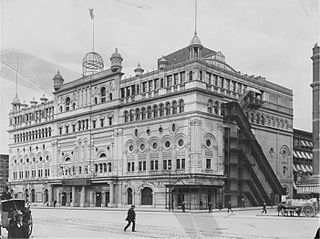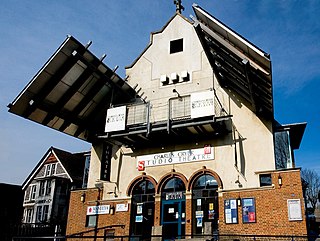Related Research Articles

THX is a suite of high fidelity audiovisual reproduction standards for movie theaters, screening rooms, home theaters, computer speakers, video game consoles, car audio systems, and video games. The THX trailer that precedes movies is based on the Deep Note, with a distinctive glissando up from a rumbling low pitch.

A black box theater is a simple performance space, typically a square room with black walls and a flat floor. The simplicity of the space allows it to be used to create a variety of configurations of stage and audience interaction. The black box is a relatively recent innovation in theatre.

The South London Theatre is a community theatre housed in a Grade II listed former fire station, in West Norwood in the London Borough of Lambeth, England. The first play opened in October 1967, and it is now a busy theatrical venue, presenting more than 22 shows annually in its theatre space, which was remodelled during refurbishment of the Old Fire Station during the period 2015–2018. The theatre facilities also consist of two dedicated rehearsal spaces, an entire floor of wardrobe rooms and a private basement bar, open Sunday to Friday evenings to audiences and members and which plays host to regular social events.

The Royal Shakespeare Theatre (RST) is a grade II* listed 1,040+ seat thrust stage theatre owned by the Royal Shakespeare Company dedicated to the English playwright and poet William Shakespeare. It is located in the town of Stratford-upon-Avon – Shakespeare's birthplace – in the English Midlands, beside the River Avon. The building incorporates the smaller Swan Theatre. The Royal Shakespeare and Swan Theatres re-opened in November 2010 after undergoing a major renovation known as the Transformation Project.

The Fox Theatre is a performing arts center located at 2211 Woodward Avenue in Downtown Detroit, Michigan, near the Grand Circus Park Historic District. Opened in 1928 as a flagship movie palace in the Fox Theatres chain, it was at over 5,000 seats the largest theater in the city. Designed by theater architect C. Howard Crane, it was listed on the National Register of Historic Places in 1985.

The University of Michigan School of Music, Theatre & Dance is an undergraduate and graduate institution for the performing arts in the United States. It is part of the University of Michigan at Ann Arbor. The school was founded in 1880 after Henry Simmons Frieze, founder and president of the Choral Union and the University Musical Society, urged leaders to include music among the school's offerings. The college was known then as the Ann Arbor School of Music. It was later incorporated into the University of Michigan with Calvin Brainerd Cady joining the faculty as the first instructor in music, after already being hired by Frieze to conduct the Choral Union.

The Hollywood Theatre is a historic movie theater in northeast Portland, Oregon, owned by a non-profit organization. It is a central historical landmark of the Hollywood District. The Theatre is located at 4122 NE Sandy Blvd, across the street from the first suburban Fred Meyer store, which is currently occupied by Rite Aid. The Hollywood Theatre was placed on the National Register of Historic Places in 1983 and is considered to be a gem of Northeast Portland's historic culture and tradition.

An atmospheric theatre is a type of movie palace design which was popular in the late 1920s. Atmospheric theatres were designed and decorated to evoke the feeling of a particular time and place for patrons, through the use of projectors, architectural elements and ornamentation that evoked a sense of being outdoors. This was intended to make the patron a more active participant in the setting.

Palladium Times Square is an indoor live events venue in New York City, located in One Astor Plaza, at the corner of Broadway and 44th Street. It was designed by architect David Rockwell and opened in September 2005. The venue has a large standing room orchestra section, combined with a large area of seating towards the rear of the auditorium.

Prudence Risley Residential College for the Creative and Performing Arts, commonly known as Risley Residential College, Risley Hall, or just Risley, is a program house at Cornell University. Unlike most other dormitories on campus, Risley is a residential college; house members, or "Risleyites," have some say in the administration of the residence hall, can continue to reside there as long as they are enrolled at Cornell, are encouraged to eat together at the in-house dining hall, and participate in educational activities such as guest lectures within the dormitory.

The Olympia Theatre, also known as Hammerstein's Olympia and later the Lyric Theatre and the New York Theatre, was a theatre complex built by impresario Oscar Hammerstein I in Longacre Square, New York City, opening in 1895. It consisted of a theatre, a music hall, a concert hall, and a roof garden. Later, sections of the structure were substantially remodeled and used for both live theatre and for motion pictures. As a cinema, it was also known at various times as the Vitagraph Theatre and the Criterion Theatre.
There are different types of theatres, but they all have three major parts in common. Theatres are divided into two main sections, the house and the stage; there is also a backstage area in many theatres. The house is the seating area for guests watching a performance and the stage is where the actual performance is given. The backstage area is usually restricted to people who are producing or in the performance.

Crying is the dropping of tears in response to an emotional state or pain. Emotions that can lead to crying include sadness, anger, excitement, and even happiness. The act of crying has been defined as "a complex secretomotor phenomenon characterized by the shedding of tears from the lacrimal apparatus, without any irritation of the ocular structures", instead, giving a relief which protects from conjunctivitis. A related medical term is lacrimation, which also refers to non-emotional shedding of tears. Various forms of crying are known as sobbing, weeping, wailing, whimpering, bawling, and blubbering.

The Broadway Theater District in the Historic Core of Downtown Los Angeles is the first and largest historic theater district listed on the National Register of Historic Places (NRHP). With twelve movie palaces located along a six-block stretch of Broadway, it is the only large concentration of movie palaces left in the United States. The same six-block stretch of Broadway, and an adjacent section of Seventh Street, was also the city's retail hub for the first half of the twentieth century, lined with large and small department stores and specialty stores.

The University Child Development Center (UCDC) at the University of Pittsburgh is a child care and early childhood education center located on Clyde Street in Shadyside just east of the main Oakland campus approximately one half mile from the center of campus at the Cathedral of Learning and adjacent to the rear property of the University's Chancellor's Residence on the Oakland-Shadyside border in Pittsburgh, Pennsylvania.
Theo Adams is a performance artist and director of the contemporary theatrical performance group Theo Adams Company.

The Empress Theatre, is an abandoned Egyptian Revival style theatre located on Sherbrooke Street west in the Notre-Dame-de-Grâce district of Montreal, Quebec, Canada. After operating for 65 years, the theater closed in 1992.

Theater Freiburg is a theatre in Baden-Württemberg, Germany.

Le Trianon is a theatre and concert hall in Paris. It is located at 80, boulevard de Rochechouart, in the 18th arrondissement of Paris, at the foot of the hill of Montmartre.

The Charles Cryer Theatre is a studio theatre located in the High Street in Carshalton in the London Borough of Sutton. The theatre is named after the man who led the campaign to open the Secombe Theatre in neighbouring Sutton. It was opened by Prince Edward in 1991. It closed in 2016, but in November 2019 it reopened under new management.
References
- ↑ "Frequently Asked Questions". Landmark Theatres. Archived from the original on 25 June 2012. Retrieved 18 August 2013.
- ↑ Bott, Tim (2009). "Cry Room Acoustics". Acoustic Sciences Corporation. Retrieved 18 August 2013.
- ↑ "Frequently Asked Questions - What is a Cry Room?". Warren Theaters LLC. Archived from the original on 12 October 2008. Retrieved 18 August 2013.
- ↑ "Cry/Toddler Room". St. Joseph's Catholic Church. Archived from the original on 15 December 2013. Retrieved 18 August 2013.
- ↑ "Question: Do you have a Cry Room or Childcare?". Saint Thomas The Apostle Roman Catholic Parish. Archived from the original on 14 August 2013. Retrieved 18 August 2013.
- ↑ "About Reading cinemas". Rhodes. Archived from the original on 2 October 2013. Retrieved 18 August 2013.
- ↑ "Crying Rooms". CMAX Cinemas Palmerston. Archived from the original on 17 September 2018. Retrieved 18 August 2013.